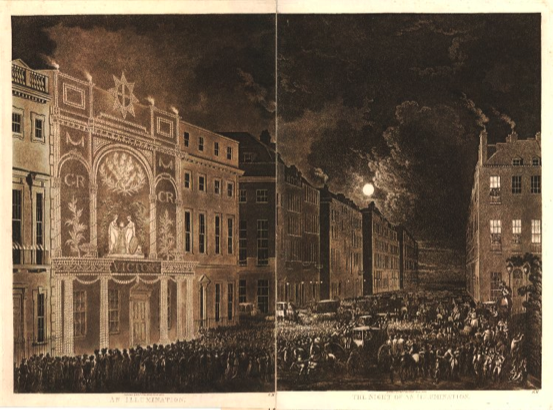Britain’s only remaining illuminations (in the true sense) are in Blackpool, where they are associated with trams, tableaux and tackiness. But where did Blackpool, first lit up in 1879, get the idea for such a display? Georgian London of course.
The London illuminations of the 18th century are a small and almost forgotten element of the pageantry of the city. This is a shame, because the evidence is that they were splendid. An illumination was the mark of a celebration: some were city-wide with every public building lit up and many private houses, and some were specific to a family or business celebrating a birth or anniversary. The point of an illumination was to make a building look spectacular. Electricity has made such a process easier and now few major buildings are not lit up at night (albeit in a sickly sodium fashion), but without electricity how were such illuminations achieved?
The answer is with lamps and transparencies, as well as interior lighting. Small lamps, protected by hurricane shades (and made specifically for outdoor use by glaziers) were placed all over the buildings in specific arrangements meant to highlight the buildings themselves, or to pick out patterns such as initials, names or shapes. Transparencies were large painted sheets which would cover one face of the building, either to make it appear to be another building such as the Pantheon or to create the illusion that Britannia herself was sitting on the windowsill. Specialist firms of painters created these enormous transparencies and the accounts of some of them are truly remarkable. One of the largest London illuminations happened on the night of Friday, April 24th 1789 on the occasion of the celebratory procession to mark George III’s ‘recovery’ from madness, when every wealthy household and every public building was ablaze in a display of patriotic support.
‘We may safely affirm that the art and means of illuminating houses were never so compleat as at this day, from the improved form of the lamps and other circumstances, there never were in England more superb illuminations, than on the late and present occasions.’
The details of these illuminations must be set in context: there was little light pollution in Georgian London, and whilst individual houses bore lamps doubling as street-lights at night the streets were dark. To light a building for illumination would have been both extraordinary, and expensive (the newspapers estimated the April 1789 illuminations would have cost not less than ‘half a million’). The following are just some of the spectacles staged that Friday night.
‘Such a blaze of light was never seen in the City since its foundation. It will be the surest testimony for future historians to record how much KING GEORGE THE THIRD, was esteemed, and dwelt in the hearts of his people….The Horse Guards was illuminated with taste. The front towards the Park was particularly fine. The Army Office had pillars of green and white, supporting the crown and other emblems, very brilliantly illuminated….St James’s-street was as luminous as ever…White’s had a beautiful transparency from the Pantheon. In the centre; the King in his coronation robes, sitting in the Coronation chair at the Abbey: the transparency was studded round with lamps, and over and on each side were stars, circles and festoons….’
The descriptions of individual houses go on for a broadsheet page. Some noble house, such as that of The Earl of Uxbridge are singled out (he had Vivant Rex et Regina spelled out in enormous blazing letters across the front of his house). Josiah Wedgewood gets a mention for his tasteful transparencies. The city synagogues of Leadehall Street and Bevis Marks were also illuminated in a show of support for the king. Mr Stackpole’s house is Grosvenor-place was picked out for not only being illuminated outside, but for having thousands of candles burning in candelabra and chandeliers inside, making the place seem ‘ablaze with light’.
The illuminations were not only for noblemen, public buildings or the super-rich: everyone who could afford to take part did and even some of the little illuminations are described. These, of course, are my favourites. Mr Angell, Mr Schneider, Mr Neale and Mr Wheeler are all singled out for their fine displays at their shops or homes, although clearly on a more modest scale to the grander buildings. And finally, a mention revealing the creativity and individuality of 18th century London in a display that would look both modern and clever now: ‘Bland’s music shop, also in Holbourne, had a singular curiosity; it was a transparency of God Save the King placed in the windows’.
The newspaper was pleased to conclude that although the ‘crouds that paraded through the street till a very late hour were incredibly large…there seemed to be more of curiosity and wonder than of riot and mischief’.

